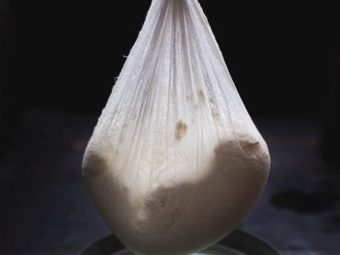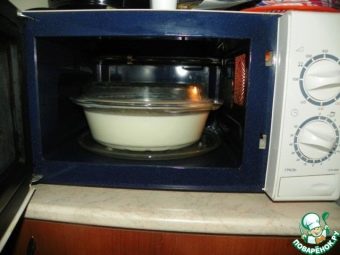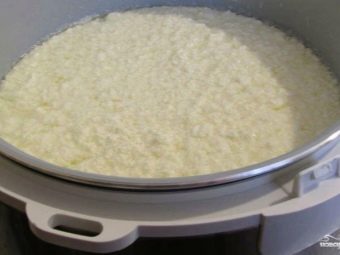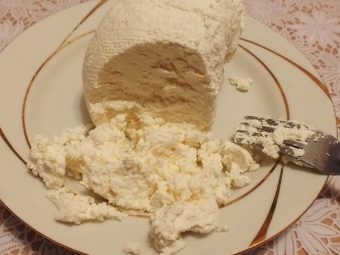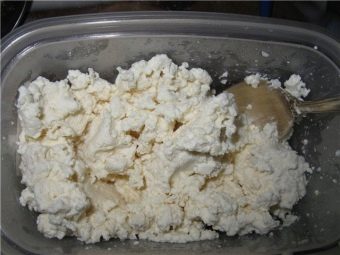How to cook cottage cheese at home?
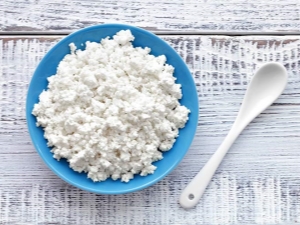
Cottage cheese is a unique dairy product, from which you can prepare a lot of delicious dishes, and you can eat it raw.But in the store it is not always possible to find a quality product with proper taste and containing a set of healing components. Therefore it is worth considering how to cook cottage cheese at home.
Composition and properties
Cottage cheese is the most common solid dairy product that has been made in different parts of the world since ancient times. At home, it was traditionally made of sour milk or sour milk by separating liquid whey from solids in a hot or cold way. Modern factory methods are different from traditional recipes; store-based cottage cheese can lose many valuable components, although it is an airy homogeneous mass, pleasant-looking, but not necessarily tasteful.
The composition of BZHU (proteins, fats, carbohydrates) varies in different types of cottage cheese. The fact is that according to the standards, this product can be divided into 3 categories of fat content: fat (more than 18%), bold or dietary (9-18%), low-fat (2-9%).
Depending on this, the standard composition of BZHU and caloric content of the dairy product are as follows:
- fat: proteins - 15 g, fats - 18 g, carbohydrates - 2.8 g, calorific value 236 kcal / 100 g;
- bold: proteins - 18 g, fats - 9 g, carbohydrates - 3 g, caloric content 169 kcal / 100 g;
- non-fat: proteins - 22 g, fats - 3 g, carbohydrates - 3.3 g, caloric content 120 kcal / 100 g
Cottage cheese, cooked at home, like other dairy products, contains lactic acid and lactose. These ingredients, along with certain enzymes, have a beneficial effect on the stomach and digestion. Of the vitamins can be noted A, C and D, as well as group B. There are in the product and useful chemical elements: calcium, phosphorus, iron.
The benefits of cottage cheese are huge, it is surely recommended for children during growth, the elderly, for fractures, diseases of the kidneys, liver and stomach, rickets, cardiovascular diseases, pregnant and lactating women. Finally, this is just a nutritious dish that can be used regularly in the diet with virtually no contraindications.
As a source of iron, amino acids and several vitamins, cottage cheese is very useful for enriching bone tissues, stabilizing the nervous system, preventing metabolism. It is proved that this product contributes to the generation of growth hormone, which is important in childhood and adolescence. Studies show that cottage cheese burns excess fat and helps with weight loss. It also helps build muscle mass, so it is widely popular among weightlifters, and is an excellent prophylactic against atherosclerosis.
Found cottage cheese and external use: it is used as compresses for bumps, cuts, bruises, burns. As a cosmetic, it is also used in the form of creams or masks for the face and body. As you can see, this is truly a universal product.
The harm of cottage cheese is largely not proven, except from the excessive consumption of the fattest varieties containing a large amount of animal fat and cholesterol.
This is a quality home-made product. This can not be said about the many dubious cheese products with chemical components that are available in many stores.
Cooking features
Cook cottage cheese at home in several ways. All of them include the following steps: the creation of yogurt from whole milk, heat treatment, pressing and removing excess liquid. An ordinary saucepan and a cooker, a water bath, a slow cooker, or a microwave oven are suitable for making. There is also a cold method of production without heat treatment.
In order to make yogurt from fresh milk, it is best to use glass or earthenware, use enameled or galvanized pots for subsequent cooking, and any suitable container, such as plastic containers, for further storage. For spinning need a piece of clean gauze, for example, medical.
To give fresh milk to ferment, and to make sour milk from it, there are several traditional ways. The main thing is to add an ingredient that contains yeast or acid that promotes fermentation. It can be a slice of rye rusk, a couple of tablespoons of sour cream or a glass of kefir, half a teaspoon of vinegar or citric acid. If you use not store, and homemade cow or goat's milk, then for reliability it is better to boil it.
Keep homemade yogurt must be stored in a warm place: near the stove, radiator, behind the refrigerator. Sunlight should not be allowed, as the useful vitamin C is destroyed from it. Three days are enough for full aging in such conditions.
In the fridge to keep the billet for yogurt should not be, as this milk does not ferment, but simply deteriorates with time.
How to choose raw materials?
Many recognize that rustic cow's milk is most suitable for making high-quality cottage cheese. It is the fattest, retains all the beneficial ingredients and does not contain additives that prevent fermentation. Not every city dweller has access to it, then it’s quite possible to use the store as well, but there are a number of nuances here.
- You need to choose a product with a fat content of at least 3.6%.
- Do not buy milk with a long shelf life, most likely, they contain antibiotics that do not allow ferment.
- Do not be lazy to look at the time of manufacture and shelf life, to acquire only fresh raw materials.
Pasteurized milk from the store is good because in any case it will not be as fat as natural. Cottage cheese from it turns out dietary and low-calorie, it is especially actual for those people who follow a diet and avoid the use of excess calories.
Rustic milk before cooking yogurt and cottage cheese usually boil. Boiled or baked milk loses a number of remarkable properties, in particular, even at a temperature of +50 degrees some useful enzymes and vitamins burn down. But in the store they are unlikely to be present, factory processing is even more merciless.
To give a special taste to home-made cottage cheese, not only coagulated milk is used, but also other ingredients of dairy origin, too. It can be in various ratios ryazhenka, kefir, yogurt. There are recipes ferment with sour cream, which serves as an oxidizer for fresh milk.
From the whey remaining after straining the solid product, it is possible to prepare tasty okroshka or dough for pancakes or dumplings.
Best recipes
For the simplest recipe for cottage cheese, take 3 l of prepared yogurt with your own hands, pour it into a five-liter saucepan and put it on a slow fire. The mass is heated, but not brought to a boil, from time to time it should be stirred. When large lumps float up, it is necessary to remove the container from the fire, let it cool and gradually pour into a colander with gauze, folded in 4 layers, large lumps to push with a spoon. Under the flowing liquid should put a separate bowl or pan. After the serum is drained, tie the gauze into a knot and squeeze it thoroughly.
Pressed curd mass is suspended in a bundle on a rope. Instead, you can use a press: cover the top of the curd with a flat plate and press it with a load for several hours.
Instead of cooking, you can cook cottage cheese in a water bath. To do this, take a large pot of water, put up a smaller container with yogurt. After boiling it is necessary to sustain the mass for a couple of 15-20 minutes, stirring occasionally.
Very quickly, you can cook cottage cheese in the microwave. To do this, 1 l of sour milk is poured into a glass or porcelain container with high sides, it is placed in the microwave oven in the open form, the power is set at 350-400 W. It takes 10 minutes to cook, after which the curd mass floats to the surface, and the whey remains at the bottom. The consistency is quite dry, it can not be pressed in gauze.
And also this milk product is simply prepared in a slow cooker. In a 5 liter bowl, pour 2-3 liters of sour milk, set the heating mode and hold for half an hour for a juicy texture or 45 minutes for dry and crumbly. After cooking, put the mass in a colander and let cool.
Without heat treatment, cottage cheese is prepared as follows. Sour milk is poured into any suitable container and put in the freezer until it freezes. Then removed and reclined in a colander, covered with gauze, which is placed on a bowl for draining serum. Next, you need to wait until the mixture has completely melted and the liquid has drained. The result is a tender and crumbly product.
Instead of yogurt, for cooking delicious curds can take a low-fat kefir. It is poured into a glass transparent container and placed in a warm dark place. When whey forms in mass, it is necessary to put the container in a water bath and heat it for 15 minutes, then separate the curd and strain it on gauze.
A delicious dessert for children can be prepared by heating 3 liters of milk to a boil, after which add 1.5 liters of kefir. Next, over low heat, the mass is heated for 10 minutes with stirring. When it is curled, then it must be cooled and filtered through a colander with gauze.
Cooked cottage cheese can be mixed in a blender until smooth with chocolate, fruit, honey, sour cream, sugar and other sweet ingredients. Treats will appeal not only to children but also adults.
From boiled village or store milk, you can prepare the product as follows. 1 l of milk is poured into an enamel pan and brought to a boil, after which the fire is turned off and half a teaspoon of salt and citric acid is added. Next, the container is placed for 4 hours under gauze, then the serum formed is drained, the curd in gauze is washed with warm water and wrung out. Serve it with cream or sour cream.
Useful tips
Without heat treatment, it is possible to preserve some useful substances in cottage cheese. Although if you freeze it, then under the influence of low temperatures in the freezer, it is also capable of losing a number of useful properties.
In the microwave for cooking should not install the greatest power. The process will not accelerate from this, and the curd may dry up, burn slightly, or it turns out to be rubber.
Modern household kitchen appliances allow you to cook this product quickly and tasty without burning and escaping milk. You can always make homemade cottage cheese in a yogurt maker, multicooker, microwave oven. Depending on the chosen mode and time, it can turn out soft and juicy or dry and crumbly.
To filter the curd mass correctly, it is necessary that the gauze be folded at least in 2 layers and protrude beyond the edges of the colander. After draining the serum, all corners of the gauze are taken and firmly connected with each other. You can hang a lump in the kitchen, as long as it is warm and dry.
It is possible to prepare a product enriched with calcium. For this, 10% calcium chloride powder must be poured into clabber, which is easy to find at any pharmacy. At 500 ml of the liquid mass is taken 1 tbsp. l substances.
But it is worth remembering that per day you need to consume no more than 100 g of a similar product, otherwise the balance of substances in the body is disturbed.
To learn how to cook cottage cheese from real cow's milk, see the next video.

